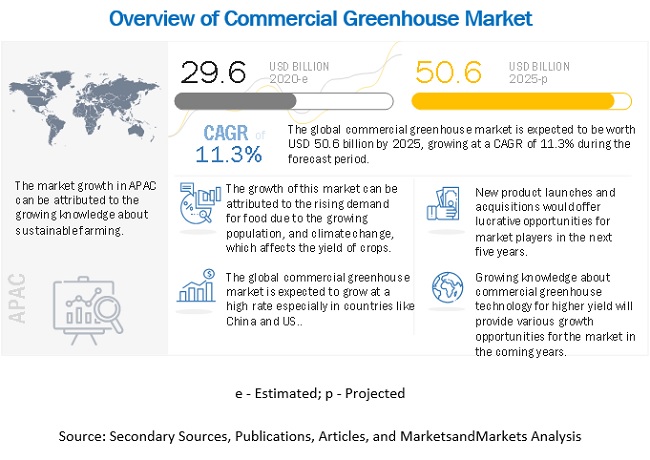The Commercial Greenhouse Market size is estimated to be valued at USD 29.6 billion in 2020. It is projected to reach USD 50.6 billion by 2025, recording a CAGR of 11.3% in terms of value. The growth of the market can be attributed to the rising demand for food due to the growing population and climate change, which affects the yield of crops. Also, growing knowledge about commercial greenhouse technology for higher yield will provide various growth opportunities for the commercial greenhouse market in the coming years.
Drivers: Higher yield than traditional methods
The adoption of greenhouse farming gives more control over the environment where crops grow. If producers can manage the temperature, the irrigation process, the air humidity, and the light efficiently, they can have a good yield. By having that much control over the growth of crops, farmers keep them healthier and can predict how much they are going to harvest. The ability to control the environment helps farmers to grow flowers, vegetables, and fruit crops all year round. Growing crops in the safe environment of a greenhouse can improve the genetics of the plant, leading to the growth of healthy varieties. It also needs less water than in an open field. Also, producers do not rely on bee pollination and can utilize all the chemicals and pesticides they use to control diseases and any other vulnerability in plants. In an open field, there are locusts, other animals, and insects that can threaten the quality of the produce.
The vine crop productivity in greenhouse farming is more than twice as high as traditional agriculture, and crop cycles are also faster due to the controlled media and environmental parameters. In addition, the land productivity of vertical farming is more than twice as high and faster as traditional agriculture.
Opportunities: Increase in the demand for floriculture and ornamental horticulture applications
Owing to a steady increase in the demand for flowers, floriculture has become one of the important commercial trades in agriculture. Hence, commercial floriculture has emerged as a hi-tech activity under controlled climatic conditions inside a greenhouse. Floriculture in developing countries such as India is viewed as a high-growth industry. Commercial floriculture is becoming important from the export angle. As per APEDA (Agricultural & Processed Food Products Export Development Authority), the country exported 16,949.37 MT of floriculture products worth INR 541.61 crores (USD 75.89 million) in 2019-20.

The Netherlands, Belgium, Colombia, and Ecuador are the major markets for floriculture and ornamental horticulture. The important floricultural crops in the international cut flower trade include rose, carnation, chrysanthemum, gargera, gladiolus, gypsophila, liastris, nerine, orchids, archilea, anthuriu, tulip, and lilies.
Challenges: Maintaining optimum climate control to grow crops all-year-round
The increase in the world’s population, accompanied by the shrinking area of arable land used to meet future food demands of the world, is already constraining Earth’s limited agricultural and natural resources. As an alternative to traditional open farming methods, plants can be grown in protected environments, such as commercial greenhouses. They comparatively yield more than the traditional farming techniques and use resources more efficiently than conventional farming. They are now receiving much attention, especially in urban and semi-urban areas.
Initially, greenhouse cropping was predominantly practiced in temperate climates. Still, interest is rapidly rising in hot, arid areas and humid, tropical regions, such as the Middle East, parts of the Asia Pacific, and Africa. However, maintaining suitable climatic conditions inside protected cropping structures in warm regions, where climatic conditions require cooling, is challenging and requires different approaches from those used in temperate conditions. The technologies for maintaining an optimum growing environment in these regions are urgently required. This can help in suitable crop growth in a proper environment to meet the needs of the growing population.
Leading companies are Richel Greenhouse (Eygalieres, FR), Argus Control Systems(British Colombia, Canada), Heliospectra AB (Gothenburg, SE), Rough Brothers Inc. (Vine Steet, Cincinnati, US), Logiqs BV (Maasdijk, NL), Lumigrow, Inc. (Emeryville, CA), Certhon (Poeldijk, Zuid Holland, NL), Hort Americas (Bedford, US), Agra Tech, Inc. (Pittsburg, US), and Nexus corporation (Northglenn, Colorado, US).
